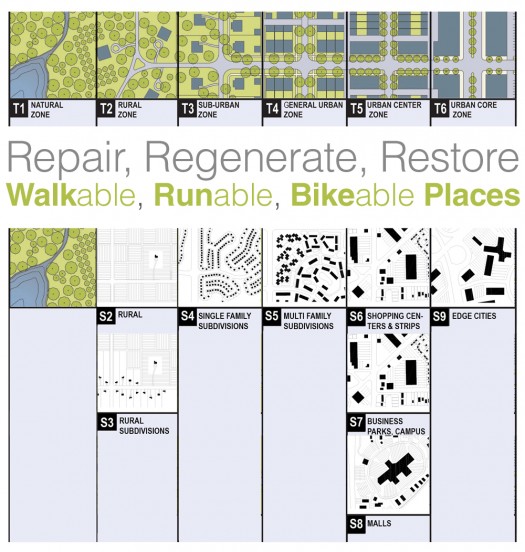A Placemaking Journal
Healthy, or Unhealthy, by Design
A few months ago, we talked about how a great city can be like a great running buddy, calling us to venture outdoors into more active, satisfying lifestyles. The photo-essay accompanying that conversation was on the urbanity of Wilmington, North Carolina. Last week, we were in another North Carolina town, Fuquay-Varina, working to create just those sorts of tightly-gridded, walkable streets connecting convivial, complete neighborhoods. Then perhaps the temptation to walk, bike, and run can overcome the lethargy of our modern lifestyle.
This time around, there wasn’t the deeply satisfying urbanism found in Wilmington within running distance from our hotel. Instead, I found a kind and interesting Town leader to run with me in the mornings, so the company and results were well worth the effort. However, “once around the block” was three miles, so clearly not the ideal walkable place.
To modify this current reality, we focused our week’s work on suburban retrofits, which would add neighborhood centers to existing auto-centric patterns, increasing connections and services in an invigorating walkable form. In the rural-to-urban spectrum below — the T1 through T6 Transect — the more urban end of the spectrum is increasingly transit and pedestrian friendly.
However, in its suburban counterparts pictured in black and white, we often talk about how they are “transit repellent” and very challenging places to add bus or rail stops because of the lack of a street network and connectivity. Not coincidentally, these same places find themselves “active lifestyle repellent” as well, offering up neither the safety nor the connections nor the interaction with other people that draws us out to run and walk and bike.
“The trouble is that in the last half century, we have effectively engineered physical activity out of our daily lives. Health is determined by planning, architecture, transportation, housing, energy, and other disciplines at least as much as it is by medical care. … The modern America of obesity, inactivity, depression, and loss of community has not ‘happened’ to us; rather we legislated, subsidized, and planned it.” And that strong statement is according to three doctors, Andrew Dannenberg, Howard Frumkin, and Richard Jackson in their book, Making Healthy Places.
If you want to delve further into reversing this reality with a suburban retrofit of your own, you’ll want to check out Galina Tachieva’s Sprawl Repair SmartCode Module along with her accompanying Sprawl Repair Manual. Also handy is Retrofitting Suburbia: Urban Design Solutions for Redesigning Suburbs by Ellen Dunham-Jones and June Williamson. After reading, if you have questions for the authors, join us for Placemaking@Work discussions with Ellen in September or Galina in February, or now, on demand.
To implement these suburban retrofit ideas, we seek examples of beloved local character which, it turns out, also tend to be the neighborhoods and cross roads — economically, environmentally and socially — with the highest performance potential. And highest degrees of satisfaction. And these places that pay, we find, are also places that play.
We study and measure such places, and then write form-based codes and land use laws that enable them — as a matter of right. Below is a selection of those types of places that we found in Fuquay-Varina last week — through this lovely set of photos by Andrew von Maur. Places that will inspire new neighborhoods that I very much look forward to walking, running, and biking through at some point in the not too distant future.
–Hazel Borys
If PlaceShakers is our soapbox, our Facebook page is where we step down, grab a drink and enjoy a little conversation. Looking for a heads-up on the latest community-building news and perspective from around the web? Click through and “Like” us and we’ll keep you in the loop.






































